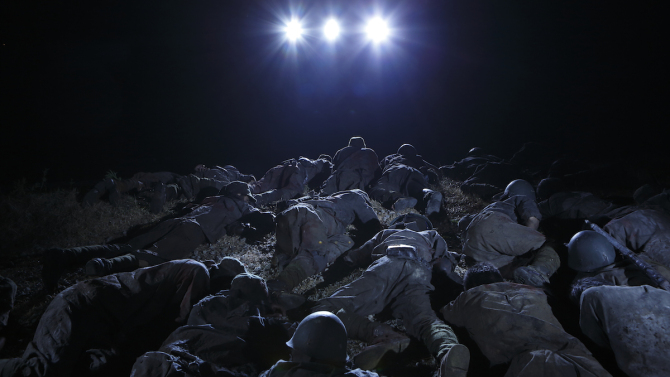There are horrors-of-war movies (“Come and See”), and then there are World War II horror movies (“Dead Snow”), and judging by “Fires on the Plain,” it’s not entirely clear whether Japanese splatter director Shinya Tsukamoto understands the difference. The “Tetsuo: The Iron Man” helmer claims to have long dreamed of filming Shohei Ooka’s 1951 novel, already adapted far more artfully by Kon Ichikawa, but he seems to be deriving a bit too much pleasure from all those decapitated heads, stacked corpses and maggot-infested flesh wounds to treat the pic’s anti-war message seriously. Despite the credibility a Venice competition slot imparts, “Fires” feels more giallo than arthouse.
Reminiscent of the stretch where Teuton hack Uwe Boll tried to earn back some respect by directing pics about Auschwitz and Darfur, Tsukamoto’s passion project represents an earnest attempt to make a statement, held back by some of the B-movie helmer’s own worst instincts. Serving as both lead actor and his own d.p. (alongside Satoshi Hayashi), Tsukamoto shoots mostly handheld in a spastic, jump-cut style, seldom lingering long enough for us to absorb, sometimes switching up angles mid-glance just to keep things jittery.
He plays private Tamura, a writer who’s been drafted into a losing war, uncomfortable with killing but forced into doing a great many uncomfortable things over the course of the film. Suffering from a serious case of tuberculosis when we meet him, Tamura is forced into the Philippine wilds when both his commanding officer and the army field clinic refuse to shelter him. He must fend for himself, surviving off blackened yams at first, and eventually on human flesh.
The entire film is designed as a subjective firsthand account of the hallucinatory hell this soldier experiences, wandering the jungle, deathly ill and on the brink of starvation. Unfortunately, Tsukamoto is an actor of severely limited range. Smeared in thick black grease, his performance amounts to clunky pantomime, ranging between stunned disbelief and wide-eyed, silent-movie shock, making it tough to get inside the character’s head.
Scripted in a hyper-linear, dot-to-dot sequence which leads little room for subtext and absolutely none for background, the film has a straightforward “and then this happened” feel, as if someone were directing straight out of the novel itself without the intermediary step of adaptation. Whether thinking of Elem Klimov (“Come and See”) or his spiritual soulmate, Terrence Malick (“The Thin Red Line”), the helmer tries to incorporate occasional glimpses of the surrounding wildlife, but cuts everything together with such hasty, disorienting abandon that we never get a sense of texture.
That he saves for the corpses, which pile up in one grand, stomach-churning setpiece where Tamura and his compatriots stumble upon an American tank (unseen, though whether for budgetary or creative reasons remains unclear). Suddenly, it’s a squib-bursting, karo-syrup-drenched bonanza, as limbs go missing, extras juggle handfuls of entrails and army boots mash animal brains strewn across the battlefield, all blanketed by smoke machines and backlit for dramatic effect. From the excessive, unconvincing makeup to the sheer glee of finally having a classy excuse to indulge some grand guignol, it all looks like one of those amateur zombie movies that used to get written up in Fangoria magazine — and that’s before the cannibalism subplot kicks in.
It doesn’t take an enormous budget or fancy directorial moves to make a powerful war story, but it’s nigh impossible without a solid script as foundation. Tsukamoto would do well to study Sam Fuller’s early work, especially “The Steel Helmet,” to see how pressure-cooker character scenes invite audience identification. Instead, he’s invested in sound effects and shocking visuals, assuming the best way to give us a taste of war is to pummel us with as many of its sensory horrors as possible. That’s not war, that’s torture.

